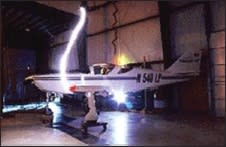NASA’s work in advanced aeronautics includes growing interest in environmentally responsive aircraft, one component of which involves use of composites to significantly reduce weight and, hence, fuel consumption. The new Boeing 787 aircraft is one recent example, and there has been a strong move toward composites in new general aviation and business jet aircraft. One disadvantage of this new direction is that the aircraft are far more vulnerable to lightning strikes. The energy deposited in a typical lightning strike involves tens of KV and 10,000-200,000 amperes, occurring in a fraction of a second. Without some type of shielding, or conductive path, the electrically insulated carbon fiber/ epoxy composites can be damaged, particularly at the entry and exit points for the strike. The aircraft instrumentation can also be damaged in such an event and extra shielding is often necessary for composite aircraft.
What are the Challenges?

What is NASA Doing?
Lightning damage detection/diagnosis technologies do not exist today for our modern fleet of aircraft, so one element of NASA’s program is to explore how this can be best accomplished both during flight and after the fact. Onboard current sensors will be used to measure the intensity and location of the lightning current during a strike. Simulations of lightning-arc events in the laboratory (see photo) with various test panels will provide baseline data for model development. The voltage/current measurements from such tests will be correlated against statistical data sets to estimate the level of damage expected on the composite and eventually to evaluate the safety risks associated with continuing the flight profile after a lightning strike has occurred.
Since the aircraft fuselage and wing structure can be very complex, it will be important to develop physics-based models of the lightning strike event. This code would allow designers to consider different material solutions for test and evaluation and eventually should allow good correlation between the model and observed lightning strike effects in the field.
What Applications Does
NASA Envision? NASA intends this information and model to be made available to composite aircraft developers as a tool in their design efforts. Similar issues are faced in the wind turbine industry where the blades can be composites. There may also be applications in the electric power industry related to arc events in very high-voltage environments.
What are NASA’s Needs?
NASA is interested in collaborating with industry or university groups in several areas.
- On-board sensors for measurement of lightning strike intensity, location, and current flow during the event.
- Conductive paint technology or other “coating” concepts for composites to facilitate current flow, hence mitigate or eliminate structural damage, and/or remove any need for additional internal shielding of electronics.
- Physics-based models of complex composite structures/actual aircraft that can be adapted to include model lightning strike events to quantify electrical, mechanical, and thermal parameters to indicate damage. More Information
For more information, contact Mr. George Szatkowski at 757-864-6194 or email

